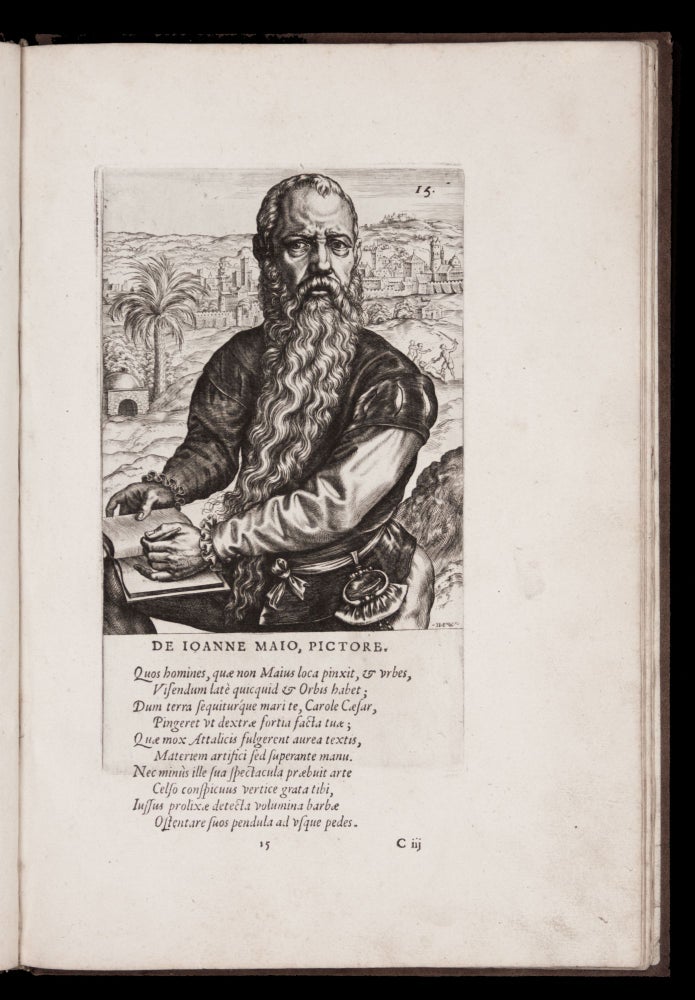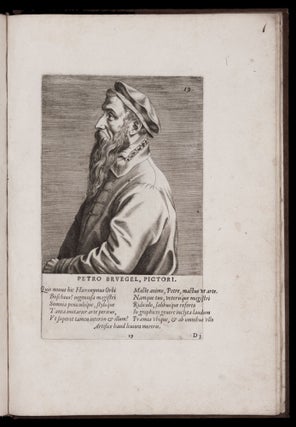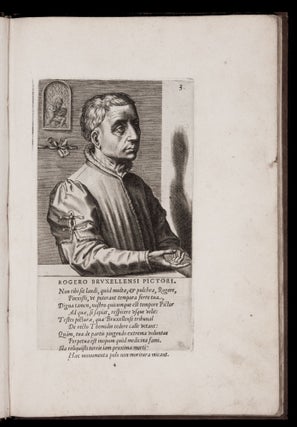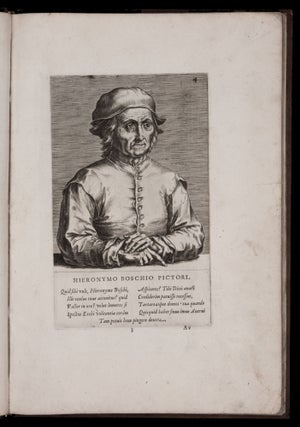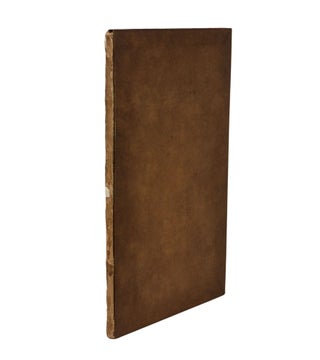Pictorum aliquot celebrium germaniae inferioris effigies.
Folio [31.0 x 20.9 cm], (1) f. letterpress title page, (1) f. letterpress verse dedication, 23 ff. full-page numbered engraved portraits with added letterpress verse text. Bound in later pasteboards, spine perishing. Occasional minor to moderate wrinkling, toning, edge wear and dustiness not affecting images (apart from plate 1, which has unobtrusive stains), a few contemporary annotations to letterpress dedication, small tear at foot of plate 7 just touching letterpress text. Very rare first edition, with all engravings in their first state, of this highly influential suite of 23 portraits of Netherlandish artists produced under the direction of the humanist-poet Dominicus Lampsonius (1532-99) and the Antwerp publisher-printmaker Hieronymus Cock (1518-70). The series, which was already in progress in the 1560s, was at last put through the press in 1572, by Volcxken Dierix, Cock’s widow, two years after the printmaker’s death. The work would thus appear to be not only the first suite of engravings devoted to portraits of artists, but it also would seem to compete in primacy with the famous series of woodcut portraits of (Italian) artists Giorgio Vasari (1511-74) commissioned for the 1568 second edition of his groundbreaking Vite. The 1572 Pictorum aliquot celebrium germaniae inferioris effigies, may, in fact, even be seen as the first Netherlandish response to the 1550 first edition of Vasari in that it “constituted the first attempt to determine a Northern canon of painting” (McCrickard, p. 33). “Appearing at a time when the artist’s status as a member of the cultural elite was ambivalent, the celebratory portrait series devoted to artists was unusual, if not unprecedented” (Meiers, p. 2). Although the volume does not contain discursive biographical text (the verses added by Lampsonius to the images are revealing but brief), its impact would long resonate in the historiography of Netherlandish art: The early art historian Karel van Mander (1548-1606), for example, quotes Lampsonius’s poems in his influential Schilder-boeck (1604), while important Low-Country artists not included in the suite (e.g., Gerard David) would in coming centuries face uphill battles to find their way into the canon. The volume’s 23 full-page engraved portraits are attributed (variously) to the brothers Johannes and Hieronymus Wierix and to Cornelis Cort, collaborators of Cock, who was one of the most important print publishers of his time in northern Europe whose publishing house ‘Aux Quatre Vents’ played a key role in transforming printmaking from an activity of individual artists into an industry based on division of craft labor. Lampsonius, a correspondent of Vasari and Lodovico Guicciardini (whose 1567 Descrittione di tutti i Paesi Bassi provided early comments on Low-Country art) and later a teacher of Peter Paul Rubens (1577-1640), penned laudatory Latin verses to accompany each half-length portrait (as well as an introductory poem lamenting Cock’s death). The artists represented are Hubert van Eyck, Jan van Eyck, Hieronymus Bosch, Rogier van der Weyden, Dirk Bouts, Bernard van Orley, Jan Gossaert (Mabuse), Joachim Patinir, Quentin Massys, Lucas van Leyden, Jan van Amstel, Joos van Cleve, Matthys Cock, Herri met de Bles, Jan Cornelisz Vermeyen, Pieter Coecke van Aelst, Jan van Scorel, Lambert Lombard, Pieter Bruegel the Elder, Willem Key, Lucas Gassel, Frans Floris and Hieronymus Cock himself, who hold a skull in reference to his recent death and/or his namesake, St. Jerome. The engravings are noted both for their high quality and for being important sources for information about painted or drawn portraits, some of which are now lost. “The quality of the twenty-three prints is consistently excellent. Details, textures, highlights and shadows of the depicted bodies are rendered with a metallic sharpness and brilliance that both acknowledges the metal plate cut with a burin and produces the rhetorical effect of enargia, the vivid description that produces a heightened appearance of ‘before your very eyes’ (Woodall, “Dry Bones,” p. 46); “The 1572 Effigies portraits display a crisp style of engraving that meticulously reproduces the various textures and details of costume, expression and gesture” (Porras, pp. 24-5). The plates offer a wealth of art-historical information. The engraving of Lucas van Leyden, for example, is based on Albrecht Dürer’s silverpoint life-drawing (now in the Musée des Beaux Arts, Lille) made during his 1521 journey to Low Countries, while the engraving of Bernard van Orley closely resembles the sitter in a Dürer portrait drawing in the Louvre (Dürer mentions in his travel diary that he sketched Van Orley). The engravings of Hubert and Jan Van Eyck are derived from figures of two riders in the ‘Righteous Judges’ panel (stolen in 1934) of the famed Ghent Altarpiece (1432), long considered self-portraits of these two formative masters. The idiosyncratic engraving of Jan Cornelisz Vermeyen has all the qualities of being based on a (now lost) self-portrait (e.g., an intense gaze as if looking into a mirror, pen held in left hand as would be the case of a mirror image of a right-handed draftsman) (see Meier for these and other iconographical observations, pp. 8-16). The portrait suite would prove to be popular in its later re-issues and reinterpretations. The present first edition has Lamponius’ verses printed (rather awkwardly) in letterpress in areas left blank at the foot of the copperplates. This, of course, required that sheets be run through the press twice, and properly aligning letter text and engraved image proved to be (too) onerous: The present example preserves an interesting bibliographical error where the text meant to accompany the image of plate 7 was first printed on the blank verso before being printed again in the correct place. To avoid such problems letterpress was soon abandoned and text was engraved directly onto the plate; this (also very rare) issue also appeared in 1572 with an imprint reading “sub intersignio Quatuor Ventorum,” and with various corrections to errors in numbering and transposition of text. The copperplates of Cock’s Pictorum aliquot celebrium germaniae inferioris effigies were sold after the death in 1601 of Volcxken Dierckx and bought by the fellow Antwerp publisher Theodoor Galle, who published an undated (c. 1602) edition of the series (with alterations) under the title Illustrium quos Belgium habuit pictorum effigies (very rare). The original plates, extraordinarily, were again used (with further alterations) in a larger suite of portraits published in London in 1694 under the title The true effigies of the most eminent painters, and other famous artists that have flourished in Europe (again, very rare). The Cock-Lampsonius suite was most widely disseminated, however, through copies (often in reverse and with substantial compositional changes) made for Hendrick Hondius’ Pictorum aliquot celebrium, praecipue Germaniae Inferioris, effigies (1610), which expanded the series to 72 plates to include contemporary artists. The portraits of the Cock-Lampsonius suite today remain the standard likenesses for most of the 23 artists depicted. OCLC locates U.S. examples of the 1572 first edition, first issue at Harvard and the National Gallery of Art (no U.S. examples of the 1572 issue with engraved text are recorded). * Hollstein, Dutch and Flemish Etchings Engravings and Woodcuts, 1450-1700: The Wierix Family Part IX, vol. 67, no. 2023; S. Porras, “Repeat Viewing. Hendrick Hondius’s Effigies,” Picturing the Netherlandish Canon, J. Woodall and S. Porras, eds. pp. 17-42; J. Woodall, “Dem Dry Bones. Portrayal in Print after the Death of the Original Model,” Picturing the Netherlandish Canon, J. Woodall and S. Porras, eds. pp. 43-77; J. Woodall, “Hieronymus Cock’s Effigies. Living Presence in Portrait Prints after the Death of the Original Model”, in The Secret Lives of Artworks, C. van Eck, ed., pp. 262-89; S. Meiers, “Portraits in Print: Hieronymus Cock, Dominicus Lampsonius, and “Pictorum aliquot celebrium Germaniae inferioris effigies,” Zeitschrift für Kunstgeschichte, vol. 69. (2006), pp. 1-16; Kate McCrickard, “Hieronymus Cock Aux Quatre Vents,” Art in Print, vol. 3, no. 6 (2014), pp. 33-5; Ignaz von Szwykowski, “Sammel-Werke Alt-Niederländer Maler-Portraits von Hieronymus Cock und Heinrich Hondius. Aus der zweiten Hälfte des 16. und zu Anfang des 17. Jahrhunderts,” Archiv für die zeichnenden Künste, R. Naumann, ed., vol. 2, pp. 13-63; J. Puraye, Dominique Lampson Humaniste, 1532-1599, pp. 64-8; J. Puraye (ed.), Dominique Lampson, Les Effigies des Peintres célèbres des Pays-Bas (1956); H.-J. Raupp, Untersuchungen zu Kunstlerbildnis und Kunstlerdarstellung in den Niederlanden im 17. Jahrhundert, pp.17-23; W. Melion, Shaping the Netherlandish Canon. Karel van Mander’s Schilder-Boeck, pp. 143-5.
Sold

